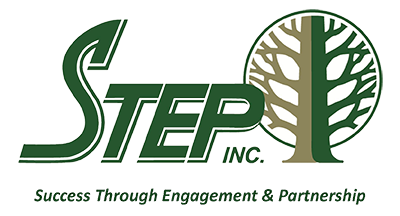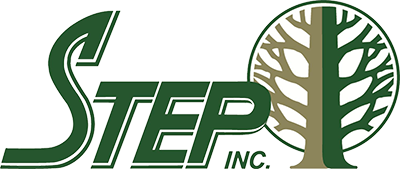What is a Community Action Agency?
STEP is a Community Action Agency. But what is Community Action? To understand community action, we will look at Community Action Partnerships, the Community Services Block Grant, and the Community Action Approach.
Community Action Agencies or Community Action Partnerships (CAAs or CAPs) promote self-sufficiency and support individuals and families striving to become economically secure while investing in the future of their local communities. This national network of over 1,000 agencies, funded in part by the Community Services Block Grant (CSBG), serves approximately 7 million families, totaling 16 million low-income persons each year. More than two-thirds have incomes at or below the federal poverty guideline when they come to their CAA.
What are the strengths of Community Action Agencies?
-
Flexibility. The Community Services Block Grant, which supplies a small but essential part of CAA funding, is unique; it is flexible, and funds local, community-specific projects or services that government agencies' "one-size-fits-all" programming cannot address. A Community Action Agency can identify and provide its community’s residents the right mix of assistance, encouragement, and incentives to become self-sufficient.
-
Immediacy. CAAs are located directly in the communities with the greatest disadvantages and are managed and staffed by skilled area residents. When a family or an individual faces a crisis, their CAA is able to respond quickly with targeted forms of assistance appropriate to the situation. Swift, direct action can often help prevent destabilizing changes that lead to costly dependency.
-
Coordination. A bedrock principle of Community Action is that resources of all kinds need to be integrated so they can be used in combination to solve community wide and individual problems. Part of a CAA’s job is to avoid duplication and help local citizens navigate the maze of public programs.
-
Collaboration. The Community Services Block Grant allows CAAs leaders the time and resources to build partnerships across the community.
-
Relevance. CAAs, by law, are led by Boards that represent the low-income community, the elected officials of the area and the private sector. They are uniquely able to choose the strategies that will use the limited resources available from all sources to address the local causes of poverty.
What is the Community Services Block Grant?
The Community Services Block Grant (CSBG) funds the nationwide network of 1,100 Community Action Agencies. These organizations create, coordinate, and deliver comprehensive programs and services to many people living in poverty in the United States in order to help individuals and families achieve self-sufficiency. It is unique in that the funding gives discretion to local eligible agencies which choose how to spend it in the most effective and efficient way for their community. It requires them to coordinate and choose among multiple kinds of public resources and other help to ‘package’ the particular resources that will change their community and give residents opportunities, One agency in a rural area may focus on facilitating access to reliable transportation for low-income people to get to work, while another agency in an urban center may prioritize community gardening so that needy residents have access to nutritious food. It is the locally-driven answer to “one-size-fits-all” funding.
CSBG-supported activities, staff and facilities are targeted toward people making 125% or less of the Federal Poverty Guideline (in most states, this means a family of four trying to live on $27,938 or less) allowing individuals and families to meet their basic needs, educate themselves, achieve self-sufficiency and improve their communities in the ways make the most sense. It means that community-wide improvements initiated with CSBG resources must primarily benefit the lowest-income residents. One of the key advantages to CSBG is that the funding is flexible, so the people who know an area best—people who live, work and raise their families there—decide what’s needed most.
History of CSBG
The 1964 Economic Opportunity Act created the Community Action Program which was funded through the Office of Economic Opportunity along with other important programs, such as the Head Start Program and Legal Services and Job Corps programs. It moved into the Community Services Administration by the early 1970’s. In 1981, the Omnibus Budget Reconciliation Act consolidated many federal programs into Block grants to the States governed by broad
conditions. One block grant, the Community Services Block Grant or CSBG, was combined the Community Action funding with several smaller programs of the Community Services Administration - Community Development, nutrition assistance, and several jobs programs. Each has been considered separately in Appropriations Bills.
Today, CSBG is the federal funding that gives Community Action its unique mission. Administered by the U.S. Department of Health and Human Services, in 2014, Community Action’s 50th anniversary, it provided $670 million divided among 58 states and territories and distributed to more than a thousand CAAs and Indian Tribal sub grantees, all locally controlled organizations.
State Oversight
Local and state organizations work together on a performance initiative called Results Oriented Management and Accountability, or ROMA, that provides a measurement and reporting framework used by CAAs to maintain the highest level of accountability and management oversight. It was updated in 2018 and includes performance indicators for federal and state agencies. States are also responsible for monitoring fiscal and program performance and for providing technical assistance to the local CSBG-funded agencies.
Statutory requirements:
All CAAs receiving CSBG funds must:
-
Be governed by a community-selected board consisting of one-third elected public officials and at least one-third representatives of the low-income community, with the balance drawn from leaders in the private sector including businesses, faith-based groups, charities and civic organizations. This “tripartite” board governance is a feature unique to Community Action. It results in plans and approaches that bring unconventional combinations of skill-sets together to solve local problems, and it empowers those who have direct experience of the barriers to economic security to participate directly in the development of effective alternatives.
-
Assess the economic and social needs of the community and serve as a principal source of information and advocacy relating to poverty-reduction;
-
Develop strategies and action plans for increasing economic opportunity and security for the community and its low-income residents; and
-
Mobilize and coordinate the resources and public-private partnerships that can carry out those strategies.
How Do Communities Put the CSBG to Work?
While there is no typical CAA, there is a common CAA approach to fighting the causes of poverty, and CSBG funding supports this unique work. The approach utilizes all available resources, human and financial, in the community to create solutions which are proactive, sustainable and effectively leveraged to deliver high-impact programs and projects which have transparent financial oversight. The Community Action approach has two broad goals:
-
To develop economic and social opportunities in the community through partnerships and investments, and
-
To help the most economically disadvantaged local citizens access resources they need to pursue those opportunities and become more self-sufficient.
The Approach is Pro-Active
CAAs prioritize proactive, preventive strategies; when families face crises they lack the resources to overcome, CAAs deliver immediate help to keep them stable, or if needed, get them back to work and schools, through difficult times. Low-wage working families and retirees are at higher risk of losing their independence than others because they lack the assets to carry them through predictable misfortunes and back to an economically secure path. In a family emergency, this preventive help is followed by long-term engagement with people and communities. CSBG–funded crisis intervention is flexible to permit the appropriate quick response to illness, divorce, violent crime or job loss that hits those without savings, health insurance and other assets; CSBG funds the accessible neighborhood-based facilities where those in need of support in a crisis can find trusted and respectful assistance and counsel; CSBG funds the professionals who mobilize targeted ‘packages’ of interventions and contributions to keep families together, seniors in their homes and workers on their job.
The Approach is Sustainable
CAAs make extended commitments to families, individuals and community partners whether the initiative is for a family’s development or for community-wide initiatives. CSBG funds the continuum of investments and coordination activities that sustain this approach. Other funders generally support distinct activities within a limited amount of time. In contrast, with their annual stream of flexible funding, CAAs can be trusted to be in place over the months and years it can take individuals to learn new skills, manage their family commitments and develop financial assets.
CAAs mobilize new financial, natural and human resources to build their community’s economy and assist its residents. The work is funded by CSBG, as no other
government funding source or charitable donation can be used for development activities. The CSBG supports the time needed to recruit, train and coordinate
nearly 50 million hours of volunteer service yearly.
CAAs create local public-private partnerships that invest in new social and economic opportunities and help local residents utilize available services and resources most effectively. CSBG helps fund those activities which imagine, initiate and build investment and service delivery partnerships. Other resources needed to implement new linkages – communications, facilities, project development costs or equipment – are typically also funded by CSBG, as these do not fall into neat
government or charitable funder categories.
The Approach Coordinates Resources and CSBG Fills Resource ‘Gaps’
CAAs manage multiple categorical programs in addition to their CSBG funding. Categorical programs are those classified by the group that is served, such as:
-
Job training and Retention
-
Services to the Homeless, including veterans and families
-
Head Start
-
Low-Income Home Energy Assistance & Weatherization
-
Homeownership and Tenant Assistance
-
Asset Development and Financial Literacy Services
While the programs for specific groups provide the resources for the benefits and services, by contrast, CSBG funding supports the people and resources that coordinate and target the right mix of programs to help an individual move ahead or to develop a multi-partner community improvement. The CSBG staff supplements and extends the impact of the conventional government and charitable programs to eliminate the causes of poverty.
The Approach Favors Innovation.
CAAs test innovative approaches and investments. Because they are charged to respond to the unique needs of their local communities, CAAs have the freedom to employ innovative approaches and investments. The successes that come from these thinking-outside-the-box strategies are then able to be shared and tested within an extensive network of other CAAs. CSBG supports CAA’s individualized approach to ameliorating poverty in a way that makes it uniquely suited to innovation.

